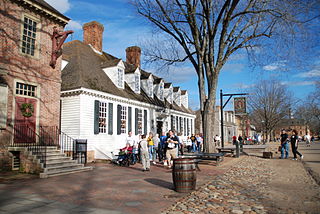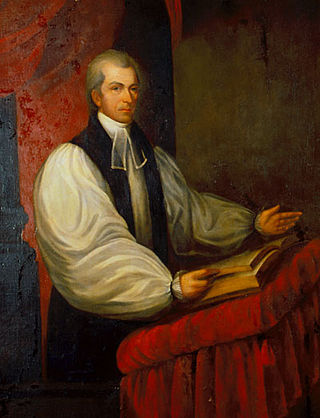
Williamsburg is an independent city in Virginia, United States. As of the 2020 census, it had a population of 15,425. Located on the Virginia Peninsula, Williamsburg is in the northern part of the Hampton Roads metropolitan area. It is bordered by James City County on the west and south and York County on the east.

The College of William & Mary is a public research university in Williamsburg, Virginia, United States. Founded in 1693 under a royal charter issued by King William III and Queen Mary II, it is the second-oldest institution of higher education in the United States and the ninth-oldest in the English-speaking world. It is classified among "R2: Doctoral Universities – High Research Activity". In his 1985 book Public Ivies: A Guide to America's Best Public Undergraduate Colleges and Universities, Richard Moll included William & Mary as one of the original eight "Public Ivies". The university is among the original nine colonial colleges.

Colonial Williamsburg is a living-history museum and private foundation presenting a part of the historic district in the city of Williamsburg, Virginia. Its 301-acre (122 ha) historic area includes several hundred restored or recreated buildings from the 18th century, when the city was the capital of the Colony of Virginia; 17th-century, 19th-century, and Colonial Revival structures; and more recent reconstructions. The historic area includes three main thoroughfares and their connecting side streets that attempt to suggest the atmosphere and the circumstances of 18th-century Americans. Costumed employees work and dress as people did in the era, sometimes using colonial grammar and diction.

The Wren Building is the oldest building on the campus of the College of William & Mary in Williamsburg, Virginia, which is the "nation’s second oldest seat of higher learning" in the United States. Situated in Old College Yard—of William & Mary's "Ancient Campus", near the more contemporary Merchants Square east of campus—the frequently visited Wren Building anchors that Campus, with its forecourt defined by two further old structures, Brafferton and the President's House. It's architecture is considered Georgian, and as a building in use by The College, and with a cornerstone laid in 1695, it is the oldest of academic buildings still standing and in use in the United States, and among the oldest buildings in Virginia. The Wren Building was designated a National Historic Landmark on October 9, 1960, and has appeared in the Virginia Landmarks Register since September 9, 1969.

James Blair was a Scottish-born clergyman in the Church of England. He was also a missionary and an educator, best known as the founder of the College of William & Mary in Williamsburg, Virginia.

The Capitol at Williamsburg, Virginia housed both houses of the Virginia General Assembly, the Governor's Council and the House of Burgesses of the colony of Virginia from 1705, six years after the colonial capital was relocated there from Jamestown, until 1780, when the capital was relocated to Richmond. Two capitol buildings served the colony on the same site: the first from 1705 until its destruction by fire in 1747; the second from 1753 to 1780.

James Madison was the first bishop of the Diocese of Virginia of The Episcopal Church in the United States, one of the first bishops to be consecrated to the new church after the American Revolution. He also served as the eighth president of the College of William and Mary. In 1780, Madison was elected to the American Philosophical Society.

The Brafferton is a building on the campus of the College of William & Mary in Williamsburg, Virginia. Built in 1723 and among the oldest buildings in Virginia, it was built as a school for Virginian Indians. The Brafferton is southeast of the Wren Building and faces the President's House. The three buildings were restored by the Colonial Williamsburg project during the early 20th century.

The history of Williamsburg, Virginia dates to the 17th Century. First named Middle Plantation, it changed its name to Williamsburg in 1699.

The Alumni House, formerly known as the Bright House, is a 19th-century building located on the College of William & Mary's campus in the middle of historic Williamsburg, Virginia. The home was originally situated on a farm called "New Hope" owned by Samuel Bright and his family and at that time on the outskirts of the town.

The history of the College of William & Mary can be traced back to a 1693 royal charter establishing "a perpetual College of Divinity, Philosophy, Languages, and the good arts and sciences" in the British Colony of Virginia. It fulfilled an early colonial vision dating back to 1618 to construct a university level program modeled after Cambridge and Oxford at Henricus. A plaque on the Wren Building, the college's first structure, ascribes the institution's origin to "the college proposed at Henrico." It was named for the reigning joint monarchs of Great Britain, King William III and Queen Mary II. The selection of the new college's location on high ground at the center ridge of the Virginia Peninsula at the tiny community of Middle Plantation is credited to its first President, Reverend Dr. James Blair, who was also the Commissary of the Bishop of London in Virginia. A few years later, the favorable location and resources of the new school helped Dr. Blair and a committee of 5 students influence the House of Burgesses and Governor Francis Nicholson to move the capital there from Jamestown. The following year, 1699, the town was renamed Williamsburg.

Julian Alvin Carroll Chandler, usually cited as J. A. C. Chandler, was an American historian, author and educator. He is best known as the 18th president of The College of William and Mary in Williamsburg, Virginia, where he served as the successor to retiring fellow educator and author Lyon Gardiner Tyler. Dr. Chandler is credited with transforming the institution from a small, struggling liberal arts college for men into a modern coeducational institution of higher learning.
Henry Cary Jr. was an American planter and building contractor, active during the early 1700s.

Saint Bede Catholic Church in James City County and Williamsburg, Virginia, is a Catholic parish in the Diocese of Richmond. The National Shrine of Our Lady of Walsingham, located adjacent to the campus of the College of William & Mary, is a part of the parish. It was the first Catholic church in Williamsburg.

The Williamsburg Bray School was a school for free and enslaved Black children founded in 1760 in Williamsburg, Virginia. Opened at Benjamin Franklin's suggestion in 1760, the school educated potentially hundreds of students until its closure in 1774. The house it first occupied is believed to be the "oldest extant building in the United States dedicated to the education of Black children".

The Bodleian Plate is a copperplate depicting several colonial buildings of 18th-century Williamsburg, Virginia, as well as several types of native flora, fauna, and American Indians. Following its 1929 rediscovery in the archives of the Bodleian Library, it was used extensively in John D. Rockefeller Jr.'s reconstruction of Colonial Williamsburg. The plate has been tied to Williamsburg resident William Byrd II and may have been produced by English illustrator Eleazar Albin and engraver John Carwitham. It is dated to the 1730s.

Lake Matoaka is a mill pond on the campus of the College of William & Mary in Williamsburg, Virginia, located in the College Woods. Originally known both as Rich Neck Pond for the surrounding Rich Neck Plantation and Ludwell's Mill Pond for Philip Ludwell who owned it, Lake Matoaka was constructed around 1700 to power a gristmill. The pond was renamed after acquisition by the college to bear the Powhatan name for Pocahontas. The lake was acquired by William & Mary in the 1920s. Construction projects by the Civilian Conservation Corps, college, and others have contributed to the lake becoming a site for outdoor entertainment and recreation.

Hearth: Memorial to the Enslaved is a memorial on the campus of the College of William & Mary in Williamsburg, Virginia. It was dedicated in 2022 to those enslaved by the university over a period of 172 years.

The College of William & Mary has maintained a campus in what is now Williamsburg, Virginia, since 1693. The cornerstone of the Wren Building, then known as the College Building and the oldest surviving academic building in the United States, was laid in 1695. The college's 18th-century campus includes the College Building, the President's House, and Brafferton–all of which were constructed using slave labor. These buildings were altered and damaged during the succeeding centuries before receiving significant restorations by the Colonial Williamsburg program during the 1920s and 1930s.

St. George Tucker Hall is an academic building on the campus of the College of William & Mary in Williamsburg, Virginia. Built in 1908–1909 from a design by Cady & See, it was William & Mary's first freestanding library and sits on what is now known as Old Campus. It is an early example of Colonial Revival architecture in Williamsburg that predated the Colonial Williamsburg restoration and reconstruction efforts. A 1928 expansion of Tucker Hall was designed by Charles M. Robinson, with a further renovation performed in 2009. The building is now named for St. George Tucker, who taught at the college. A statue of James Monroe, a U.S. president and alumnus of the college, was installed in front the hall in 2015.






















